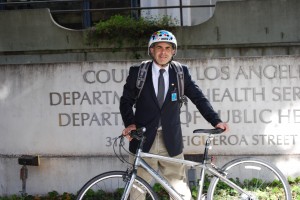It’s clear Katz finds these clinic hours deeply satisfying, but the effect is much more practical. His time in the clinic informs his priorities as an administrator: he sees the road blocks and tries to clear them. Katz’s primary aim though, and what he came to Los Angeles to do, is to steer low-income Angelenos away from the emergency rooms they’ve long relied on and into primary care clinics where problems, like a tumor, can be detected earlier.
"They sent me the L.A. org. chart. I said, 'Where’s primary care?' Well, it’s under the hospital," Katz told me. "Well, that may explain why you have a problem with primary care!"
Katz has moved swiftly. In the last six months, his team has assigned nearly a quarter of a million people to a primary care doctor at county clinics without hiring any additional staff.
"What I did is say, 'No, we’re not running this anymore as a drop-in--see who you see and no one is responsible,'" Katz says.
Katz’s predecessors promised many of the same reforms, but government observers here say they were stymied by a Board of Supervisors which often governs Los Angeles like five competing fiefdoms. Indeed, many of the people I interviewed said they advised Katz not to take the job, that Los Angeles was beyond repair. But that sense of resignation may have worked to Katz’s advantage, says Michael Cousineau, a professor at the University of Southern California’s Keck School of Medicine. "People are just so tired of failure," Cousineau told me.
And the stakes have gotten higher. Under the federal health law, the federal government will sharply reduce payments to public hospitals that treat the uninsured. That's because, in 2014 when the federal health care law goes into effect, nearly all those who are legally documented will have health insurance coverage. In Los Angeles, says Howard Kahn, CEO of the county health insurance plan "L.A. Care," that means millions of newly insured people. People who have long had no choice but public clinics and hospitals will be able to switch to private providers, a worrisome prospect for the county.
"They have a realistic concern that that’s going to happen," Kahn says, "if they don’t improve customer service."
One report commissioned by the county put it bluntly--if LA loses its paying customers and is left treating only the undocumented, the financial survival of its health system is at stake. USC Professor Cousineau agrees. "To move it rhetorically from a system of last resort to a system of choice is not going to be an easy thing," Cousineau said. "But the price of failure is thousands of people losing their jobs, closing of health centers. So that’s what the supervisors have to grapple with."
For their part, the Supervisors seem supremely, and unusually, confident in Katz’s initiatives. Supervisor Gloria Molina represents East Los Angeles and says "I was one that was worried he was just going to be another guy that just took us so far and then would leave us. But instead he’s had the most daunting challenges and he’s meeting all our expectations."
One test of Katz’ vision for re-making L.A.’s system is taking place at the heart of where it all went terribly wrong. The Martin Luther King Junior-Harbor Hospital in South L.A. closed in 2007 after it reached near-third world standards and one patient died of egregious errors. It’s now re-opened as a clinic where patients with chronic diseases are counseled by a team of nurses and medical assistants.
The clinic’s nurse manager Kimberly Thomas says customer service is now a top priority, "The patients like the fact that they have someone to call. That they know WHO to call," she says, then adds there are additional incentives for better health. "They’ll bring patients who have diabetes and high cholesterol then bring them in again and look at their labs and see if they’re improved or gone down. And they give gifts to people who are most improved, and they really love that."
Assigning low-income patients to a medical home makes for better medicine, but whether it engenders good will and loyalty when these same patients gain insurance is an open question. And this may, in fact, be Director Katz’s greatest challenge: giving Angelenos a reason to believe in what the county can offer.
More:
Listen to the audio version of Sarah Varney's piece:
